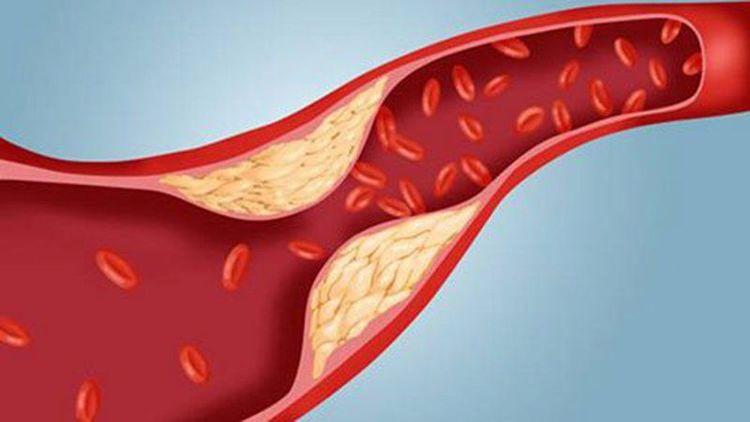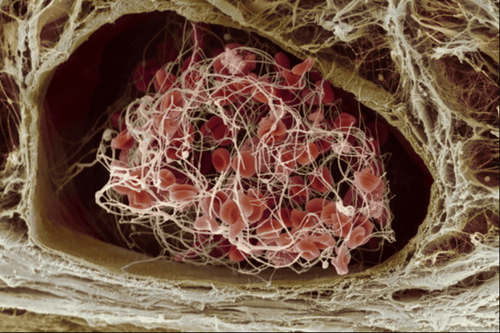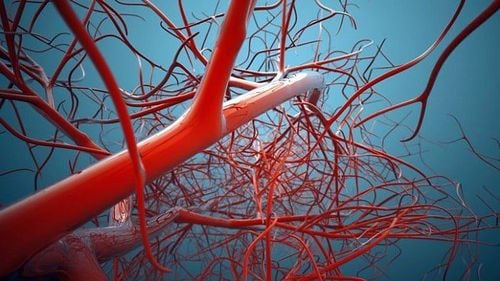This is an automatically translated article.
Thoracic aortic segment replacement surgery has been considered the standard in the treatment of thoracic aortic aneurysms for decades. Nowadays, this method is gradually being replaced by new more effective techniques.
1. Treatment of thoracic aortic aneurysm
The aorta is the largest artery in the body, helping to carry oxygenated blood from the heart to the rest of the body. The part of the aorta that runs through the chest is called the thoracic aorta and is responsible for supplying blood to the heart, brain, head, neck, and spine.Thoracic aortic aneurysm is a dilated segment of the thoracic aorta, with a dilated segment diameter ≥ 1.5 times the diameter of the adjacent normal artery. Thoracic aortic aneurysm is divided into 2 types:
Pseudoaneurysm: The cause is usually infection, trauma, or penetrating ulcer of the aorta, damage to a point on the vessel wall, progressive damage to the face. The side of the aorta bulges into a sac, asymmetrically. True aneurysm: The thoracic aorta is structurally changed due to many reasons such as old age, hypertension, smoking, high blood fat, atherosclerosis causing stenosis of the thoracic aorta,.... This change causes a segment of the thoracic aorta to weaken and dilate to form an aneurysm. Aneurysms are usually rhombic in shape, and the aneurysm shell has a vascular structure. A thoracic aortic dissection is when blood flows through a small tear in the vessel wall to create a new flow between the inner and outer layers of the artery. Thoracic aortic aneurysm and thoracic aortic dissection are two closely related conditions. Thoracic aortic aneurysms can cause thoracic aortic dissection and thoracic aortic dissection can also cause aneurysms because the dissection weakens the vessel wall.
Thoracic aortic aneurysm often has few symptoms, the disease is discovered incidentally when the patient is prescribed a chest X-ray when examining another disease. A small number of patients present with atypical symptoms such as vague pain in the neck and lower jaw, back pain, left shoulder pain, or pain between the shoulder blades. When large bulges compress surrounding structures such as trachea, esophagus, ... will cause difficulty in swallowing and breathing. If thoracic aortic dissection occurs, the patient will experience sudden pain such as tearing in the front or back of the chest.
Thoracic aortic aneurysm is a dangerous disease, in which the most dangerous complication is rupture of the aneurysm, leading to tearing of the artery wall causing life-threatening bleeding.
Treatment of thoracic aortic aneurysm in the early stages when the diameter of the aneurysm is small, there is no indication for surgical intervention, will be treated medically based on the cause of the disease. Like aneurysms caused by hypertension, they will be treated with antihypertensive drugs, a low-salt diet, increased exercise, etc. Aneurysms caused by atherosclerosis will be treated with drugs to reduce blood lipids. , diet to reduce cholesterol and fat, quit smoking,... Treatment of thoracic aortic aneurysm due to infection with high-dose, broad-spectrum antibiotics, anti-inflammatory, improving fitness,...
For With true aortic aneurysm (pathological aneurysm), treat thoracic aortic aneurysm surgically when the aneurysm diameter is 2 times the diameter of the adjacent aorta or the aneurysm diameter is 35 mm but with periodic monitoring an increase of ≥4mm/every 6 months or aneurysm diameter ≥35mm associated with multiple thrombus within the aneurysm was observed. The patient must be in good general condition, with no contraindications to surgery due to other diseases. When an aortic aneurysm shows signs of rupture or threatens to rupture, surgical intervention is required immediately.
For pseudoaneurysm, surgical intervention is indicated for any degree of aneurysm if the patient is in good condition, there are no contraindications to surgery due to other pathologies.

Phình động mạch do xơ vữa thành mạch
2. Thoracic aortic segment replacement surgery
Surgical replacement of the aneurysm of the thoracic aorta under the extracorporeal circulation with an artificial vessel is the classic treatment for thoracic aortic aneurysms. There are many different types of artificial circuits such as Dacon circuit, Gore-tex circuit, silver coated circuit,... Each type of artificial circuit has its own characteristics and advantages. However, in general, thoracic aortic replacement surgery is a large and complicated specialized surgery, patients have to endure a lot of pain, long operative time with high risk of complications and mortality (over 50%).
Endovascular intervention (stent-graft placement) is a minimally invasive vascular treatment, developed in recent years and is gradually replacing traditional aortic segment replacement surgery. The essence of this method is to place a graft into the aortic cage with an aneurysm to replace the function of blood conduction and disable the aneurysm, adjusting the blood flow in the vascular lumen properly. Endovascular intervention is especially advantageous in patients who are elderly, weak, in poor health or contraindicated with thoracic aortic replacement surgery due to other diseases such as coagulopathy, chronic disease, etc. Endovascular intervention reduces the number of days in the hospital, reduces complications and the risk of death.
Hybrid is a modern technique, combining surgery and cardiovascular intervention, which effectively treats complex cardiovascular diseases compared to traditional methods. If performing thoracic aortic segment replacement surgery in thoracic aortic aneurysms will be very complicated, the patient mortality risk is more than 50%. However, using the Hybrid technique to bridge the ascending aorta and the subclavian carotid artery, and then placing stent-grafts to cover the lesions, the patient mortality rate will be reduced to <10%.

Bệnh nhân rối loạn đông máu không được chỉ định can thiệp nội mạch
Vinmec International General Hospital with a system of modern facilities, medical equipment and a team of experts and doctors with many years of experience in medical examination and treatment, patients can rest assured to visit examination and treatment at the Hospital.
To register for examination and treatment at Vinmec International General Hospital, you can contact Vinmec Health System nationwide, or register online HERE.
MORE
Heart arrhythmia, what you need to know! How dangerous is aortic aneurysm and how is it treated? Percutaneous aortic valve replacement (TAVI): The optimal solution for people with aortic valve stenosis













